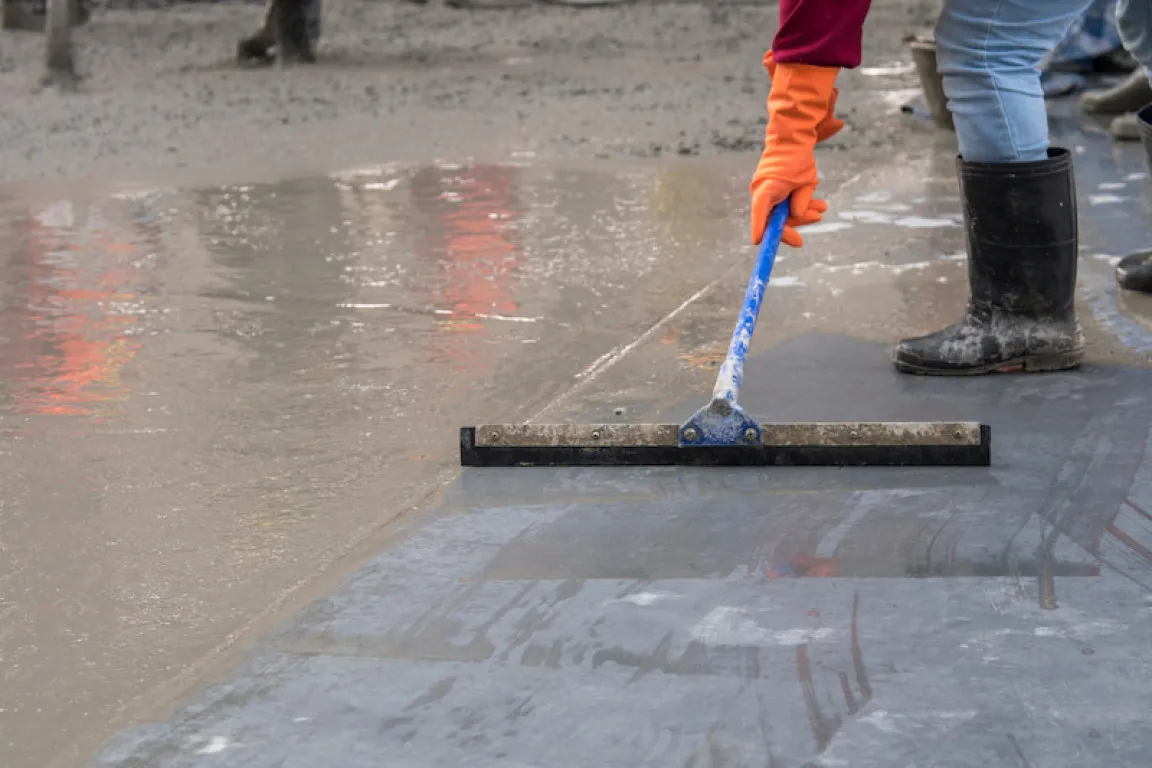Concrete curing is one of the most crucial processes in construction, directly affecting the quality and durability of concrete. Without proper curing, concrete tends to harden too quickly, which can lead to cracks and reduce its strength over time.
This concrete maintenance process is performed after the concrete enters the hardening phase, utilizing various methods, such as applying a curing compound. This compound forms a protective layer to reduce water evaporation. To better understand the importance of concrete curing, let's check out more details below!
What Is Concrete Curing?
Concrete tends to harden quickly and lose moisture, which can significantly impact its quality. To prevent this, concrete curing becomes an essential step in concrete maintenance, as this method effectively retains moisture and strengthens the concrete structure.
Curing is performed after the concrete surface enters the hardening phase. Once the concrete reaches this phase, the stability of the chemical compounds within the concrete can be maintained.
If curing is done too early or before the hardening process, the chemical compounds in the concrete may not yet be stable, potentially damaging its structure. On the other hand, if curing is carried out too late after the concrete has hardened, its effects are no longer optimal, as the concrete has already lost the ability to benefit from this process.
Functions of Concrete Curing
As previously explained, the primary function of concrete curing is to maintain the quality of concrete by preventing rapid moisture loss. Here are some specific benefits you can gain from this method:
- Maintaining Concrete Moisture: Prevents water loss on both the surface and internal parts of the concrete, especially during the initial hardening phase.
- Regulating Concrete Temperature: Keeps the concrete's temperature stable and in line with its surrounding environment, reducing the risk of damage due to weather changes.
- Reducing Water Evaporation: Minimizes evaporation, particularly during the first few days and when the concrete is exposed to sunlight.
- Preventing Concrete Cracks: Maintains moisture and water levels to reduce the risk of cracking caused by excessive water loss.
- Enhancing Concrete Strength: Allows the concrete to reach optimal hardness and strength, ensuring durability.
- Preserving Dimensional Stability: Ensures the concrete does not shrink or undergo excessive dimensional changes that could compromise structural quality.
Read also: Concrete Rebate: Definition, Functions, and Advantages
Concrete Curing Methods
To ensure the curing process aligns with the desired concrete grade, it must be carried out using specific methods. Here are several types of methods and information on how long concrete curing should be applied correctly:
1. Concrete Curing with Evaporation
The evaporation method for concrete curing is typically applied in the production of concrete tiles. This method involves adjusting the temperature between the concrete and the environment, either at low or high pressure, to optimize the concrete's strength.
This method is suitable for areas with cold climates but requires specialized equipment, skilled personnel, and higher costs compared to other curing methods. Before evaporation, the concrete must be rested and moistened several times over a few days.
Evaporation is performed after the concrete has been stored at a temperature of 10-30°C. The evaporation process can involve high pressure (65-95°C) for 10-16 hours or low pressure (10-30°C) for 10-12 hours.
2. Concrete Curing with Liquid
Another method for concrete curing involves using water to spray the concrete once it has entered the hardening phase. The main goal is to reduce water evaporation on both the surface and within the concrete.
This method has several advantages, which are practical, cost-effective, and can be used for various types of concrete, such as concrete pipes, box culverts, and paving blocks. However, it is not recommended for road construction projects, as the wet concrete surface may block water spraying.
The concrete curing process with liquid is considered complete once all the liquid has been absorbed into the concrete structure. Additionally, applying a curing compound for a short time can be considered an alternative to more effectively reduce water evaporation, especially in hard-to-access areas or regions with high temperatures.
3. Concrete Curing with Geotextile
You can also use non-woven geotextile material to maintain concrete structures. This material is applied directly onto the concrete surface as a membrane or water evaporation barrier to prevent the concrete from drying too quickly.
Before application, ensure the membrane is dry for at least 4 hours. Additionally, verify that the membrane is shaped like a film, free from fine holes, adheres well, and does not contain harmful substances, such as toxins, that could compromise the concrete's quality.
This method is particularly useful in areas with limited water supply. Besides not requiring water, curing concrete with geotextile can be performed without waiting for the concrete to pass the hardening phase. Moreover, geotextile curing helps maintain the quality of the concrete for an extended period.
Read also: Concrete Compressive Strength: Definition and Underlying Factors
4. Concrete Curing with Infrared
Concrete maintenance can also be carried out using infrared rays. If you're interested in applying this method, you can start by exposing the concrete, which has already entered the hardening phase, to infrared rays at a temperature of 90°C for approximately 3-4 hours.
5. Concrete Curing with Hydrothermal
Another method you can apply is hydrothermal curing. With this method, you use heated molds to shape the concrete. The concrete mixture is placed into a specialized mold heated to 65°C and then left for several hours.
Factors that Affect Concrete Curing Quality
In addition to choosing the curing method, there are several other factors that determine the quality of concrete curing results. Here are the factors to consider when maintaining concrete structures with this curing method:
- Quality or strength of the concrete.
- Durability and stability of the concrete structure.
- Resistance of the concrete to water seepage.
- Surface wear resistance against friction with other objects related to durability.
- Concrete volume stability, especially in relation to shrinkage potential.
That is the information about concrete curing. Concrete curing is the key to maintaining the strength and durability of concrete structures. With the right methods and careful execution, you can ensure that the concrete remains of high quality and durable.
Additionally, selecting quality building materials from the outset is crucial to reducing the risk of future damage. Therefore, don’t hesitate to choose premium-quality concrete from Semen Merah Putih.
Semen Merah Putih offers the best solutions with ready-mixed concrete available in various options suitable for construction needs, from high-rise buildings to large-scale infrastructure. We also provide precast concrete designed to speed up the construction process while ensuring quality and durability.
Contact us now for more information and the best solutions for your sturdy and long-lasting building!



